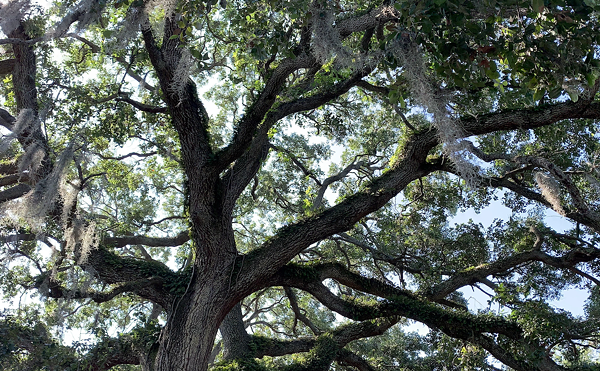In the mid-1970s, along with famed artists Robert Zakanitch, Valerie Jaudon, Joyce Kozloff and others, she helped found the P&D movement, also known as Pattern Painting. P&D artists, often employing an underlying grid, reinterpreted designs hinting of ancient and exotic origins, or of quilt-making legacies, a Schapiro favorite.
Pattern painting enjoyed popularity during the late '70s and early '80s, and was enormously successful in Europe. "It was the first time in my life I'd ever seen real money," Schapiro says.
P&D was eventually subjected to derision, ironically because of its strong aesthetic appeal. Yet those condemning the style may have missed something — a craving for beauty that is innately human.
PICTURES AT AN EXHIBITION
Miriam Schapiro in Tampa offers strong proof that beauty can be enough.
Twenty works from the late '70s to the present offer a partial overview of the artist's oeuvre.
Dolls figure into several images. The subject matter may seem naive for a contemporary artist (though James Rosenquist has a painted series), but Schapiro's use of them is anything but naive. "Curtain Call" places its cast of doll characters against a theatrical background — another familiar Schapiro device — and "Big Boy #1," one of her favorites, bridges dolls and pop culture. In the richly hued "Life of Dolls" (2003), randomly placed dolls are visually stabilized by the rigid geometry of a circle and rectangle.
Schapiro's familiar visual motifs — her "lexicon of forms" — are everywhere: fans, hearts, houses, robes called "vestitures," kimonos endowed with cross-cultural and cross-gender meanings. Simple, but not simplistic.
In "The Poet" (1983), a huge, ironic but noble tribute to women, a gentle maelstrom of whirling hearts, houses and teapots is scattered randomly against a field glowing with pinks, reds and oranges.
During the late '80s, the artist began a commemorative series on revered feminist cult figure Frida Kahlo. "Frida and Me" is a 1990 lithograph based on the monumental (72" x 152") "Conservatory" (1988), a glorious, hard-to-tear-yourself-away-from melange of paint and fabric (shown in a 1999/2000 retrospective at Lakeland's Polk Museum of Art). Schapiro biographer Thalia Gouma-Peterson suggests the Frida/Miriam composite portrait infers common Jewish heritage (Kahlo was half Jewish), of growing interest to an artist who has only recently begun to express her own ethnicity and religion in her art.
But not all the art in the exhibition reveals her sensuous side.
During the mid-1990s, prompted by her Russian/Jewish heritage, the artist devoted a series to Russian women artists. "Women Artists of the (Russia's) New Age," xerox on cut paper, combines patterns, costumes, hearts and doilies, and a realism we're unused to seeing in her work. "Sorrow and Joy" (2003) is unique for other reasons. A poignant interpretation of the 9/11 event, its grayed tones are subtly touched by color. The mythological Persephone figure signals the promise of regeneration and rebirth.
BORN AGAIN
"We see so many people working today who don't know to whom they owe their debt," says Norma Roth. She and her husband, William Roth, prominent benefactors of the Polk and Orlando Museums of Art, are listed by Art & Antiques Magazine as among the top 100 collectors in the country.
They are perhaps Schapiro's biggest fans; they donated a huge Schapiro triptych to the Orlando Airport, and are major collectors of P&D. The Roths understand Schapiro's contributions as well as anyone.
And indeed, her contributions to subsequent generations of women artists are nearly incalculable. She helped found the feminist journal Heresies, and lectured, earning the nickname "Mimi Appleseed" after collecting slides from unknown female artists and sharing them with other women — the "largest private archive of woman artists," she says.
And the accolades that signify success for an artist are legion: work in major museum collections around the world; six honorary doctorates; numerous awards, including the 2000 College Art Association's Lifetime Achievement Award.
But what continues — what's most important — is the work. And Schapiro, at 80, is working at a level as high as she ever has.
"Asian Rendezvous" (2003), a femmage absent from this exhibition, illustrates the artist's ability to surge at this stage of her life and career. Brazenly decorative, with exquisite yellow-gold coloration, it is by all measures a consummate synthesis of fabric and paint. When I viewed it in the artist's N.Y. gallery, I was struck by its triumph of delicacy and dynamism, oriental motifs and floral patterns coalescing into a cosmic universe. Works like these — in any media — satisfy a deep-rooted, unapologetic, turn-back-the-clock celebration of beauty.
















